Dissertation: Brand Image, Satisfaction & Loyalty (Waitrose & Tesco)
VerifiedAdded on 2023/04/12
|15
|2807
|293
Thesis and Dissertation
AI Summary
This dissertation proposal investigates the impact of positive brand image and customer satisfaction on brand loyalty, with a specific focus on Waitrose and Tesco. The research will explore the relationship between brand image, customer satisfaction, and customer loyalty, examining the marketing techniques employed by these two retail supermarket chains. The study aims to determine how a positive brand image and high customer satisfaction levels can increase customer loyalty, influencing purchasing behavior and creating a strong customer base. The methodology includes literature review, research methods, sampling techniques, data collection, and ethical considerations, using a descriptive research design. The proposal outlines the research objectives, questions, and a timeline for the dissertation, including a budget. It also includes a literature review that discusses brand image, customer satisfaction and their association with brand loyalty.
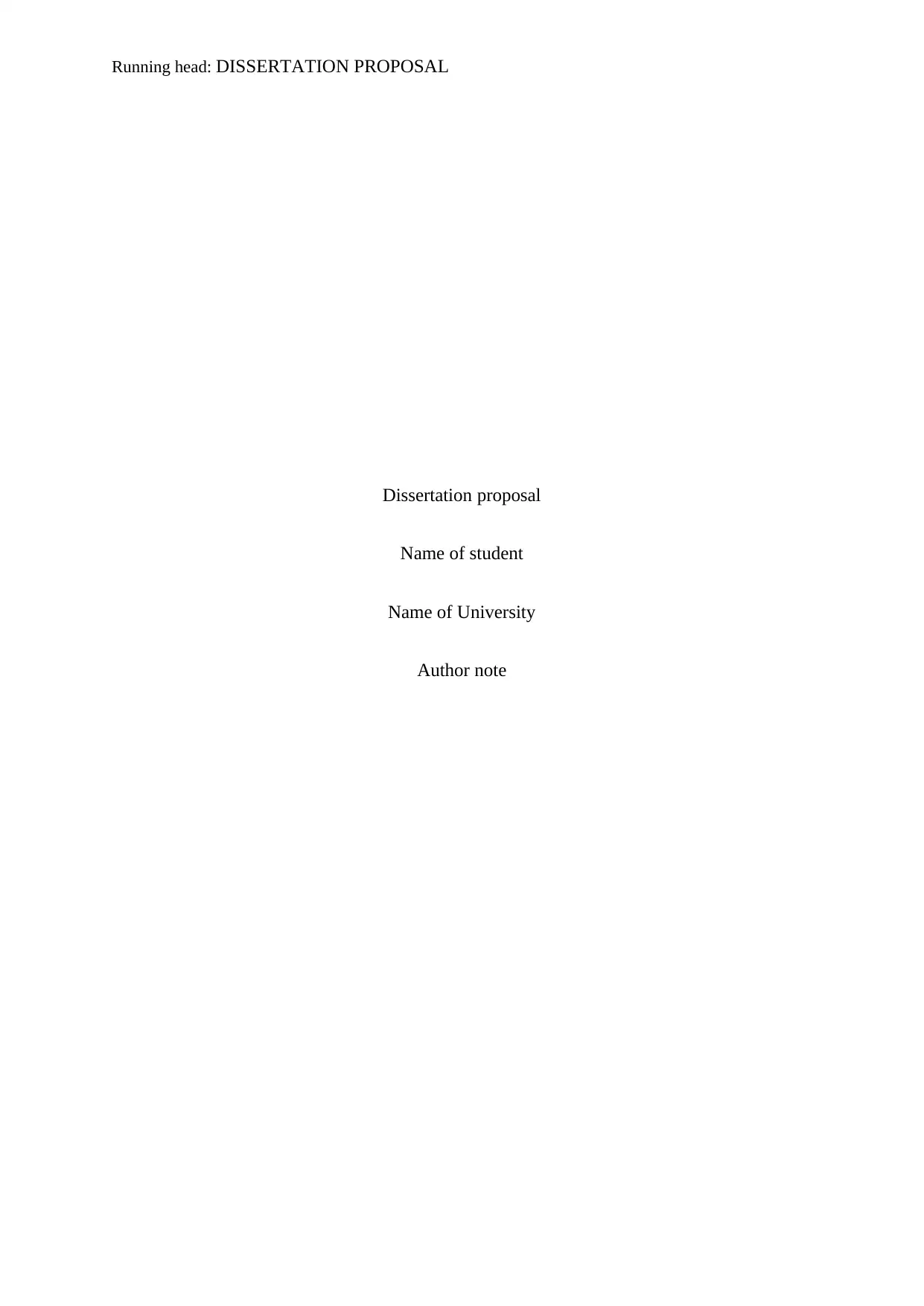
Running head: DISSERTATION PROPOSAL
Dissertation proposal
Name of student
Name of University
Author note
Dissertation proposal
Name of student
Name of University
Author note
Paraphrase This Document
Need a fresh take? Get an instant paraphrase of this document with our AI Paraphraser
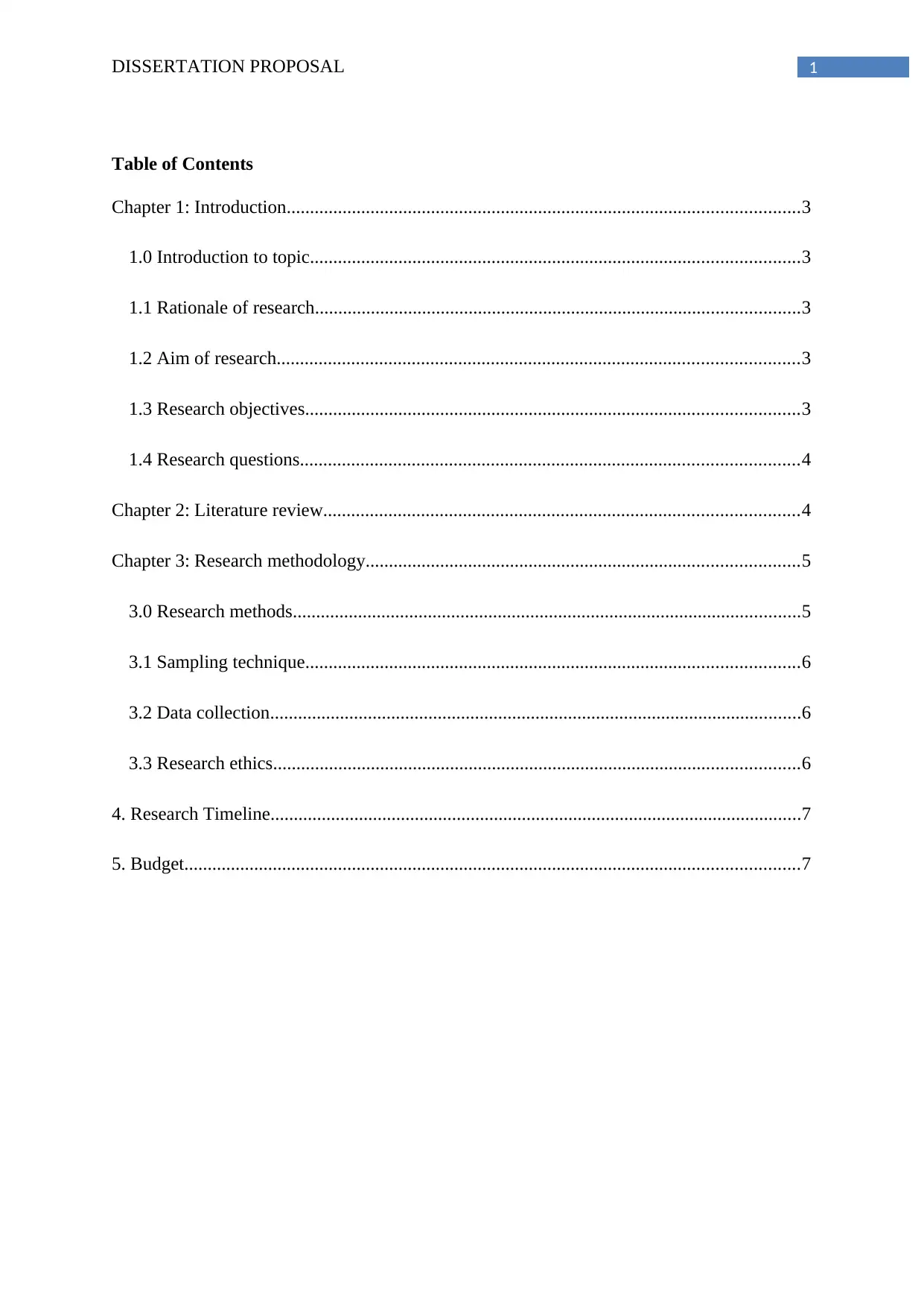
1DISSERTATION PROPOSAL
Table of Contents
Chapter 1: Introduction..............................................................................................................3
1.0 Introduction to topic.........................................................................................................3
1.1 Rationale of research........................................................................................................3
1.2 Aim of research................................................................................................................3
1.3 Research objectives..........................................................................................................3
1.4 Research questions...........................................................................................................4
Chapter 2: Literature review......................................................................................................4
Chapter 3: Research methodology.............................................................................................5
3.0 Research methods.............................................................................................................5
3.1 Sampling technique..........................................................................................................6
3.2 Data collection..................................................................................................................6
3.3 Research ethics.................................................................................................................6
4. Research Timeline..................................................................................................................7
5. Budget....................................................................................................................................7
Table of Contents
Chapter 1: Introduction..............................................................................................................3
1.0 Introduction to topic.........................................................................................................3
1.1 Rationale of research........................................................................................................3
1.2 Aim of research................................................................................................................3
1.3 Research objectives..........................................................................................................3
1.4 Research questions...........................................................................................................4
Chapter 2: Literature review......................................................................................................4
Chapter 3: Research methodology.............................................................................................5
3.0 Research methods.............................................................................................................5
3.1 Sampling technique..........................................................................................................6
3.2 Data collection..................................................................................................................6
3.3 Research ethics.................................................................................................................6
4. Research Timeline..................................................................................................................7
5. Budget....................................................................................................................................7
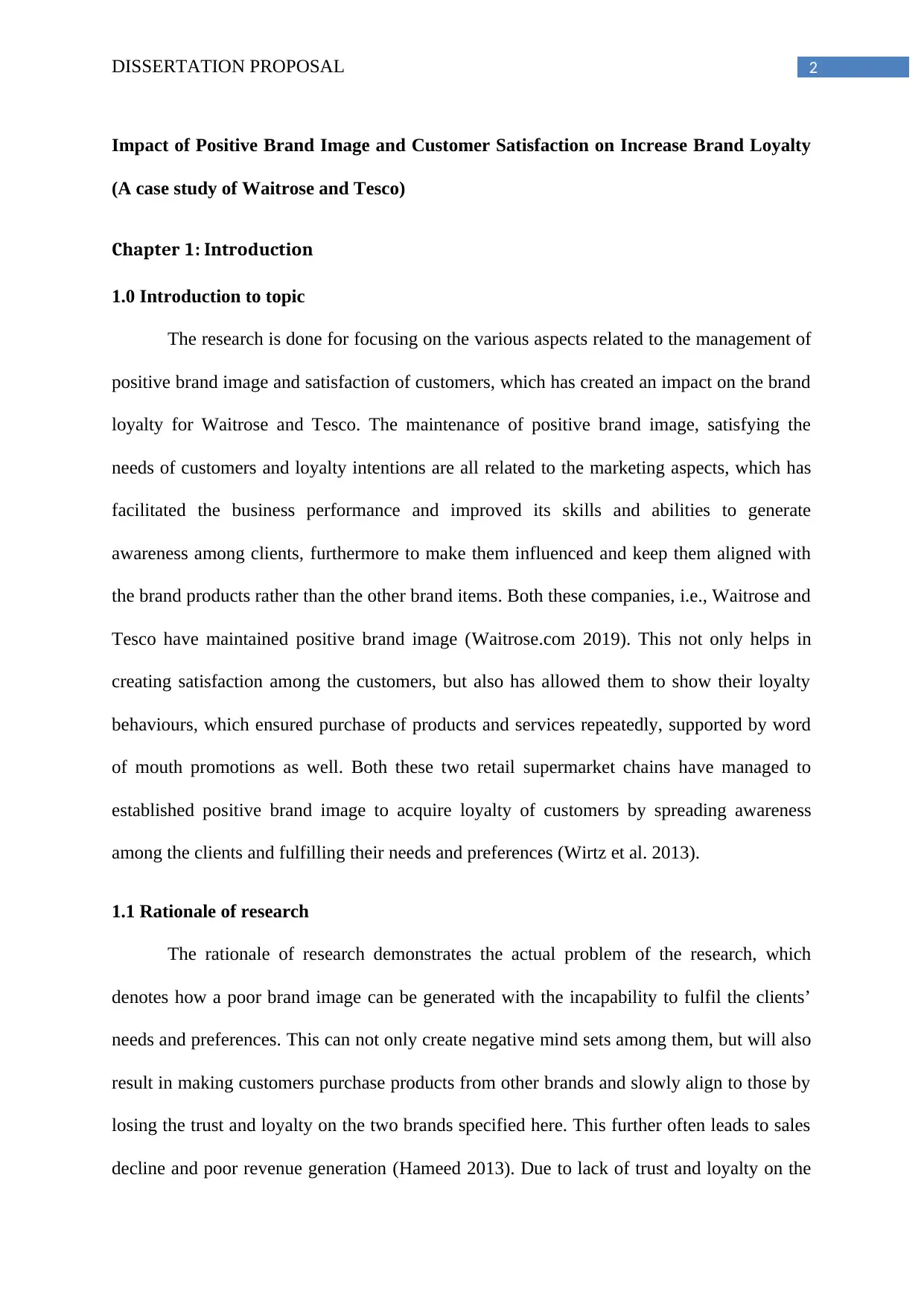
2DISSERTATION PROPOSAL
Impact of Positive Brand Image and Customer Satisfaction on Increase Brand Loyalty
(A case study of Waitrose and Tesco)
Chapter 1: Introduction
1.0 Introduction to topic
The research is done for focusing on the various aspects related to the management of
positive brand image and satisfaction of customers, which has created an impact on the brand
loyalty for Waitrose and Tesco. The maintenance of positive brand image, satisfying the
needs of customers and loyalty intentions are all related to the marketing aspects, which has
facilitated the business performance and improved its skills and abilities to generate
awareness among clients, furthermore to make them influenced and keep them aligned with
the brand products rather than the other brand items. Both these companies, i.e., Waitrose and
Tesco have maintained positive brand image (Waitrose.com 2019). This not only helps in
creating satisfaction among the customers, but also has allowed them to show their loyalty
behaviours, which ensured purchase of products and services repeatedly, supported by word
of mouth promotions as well. Both these two retail supermarket chains have managed to
established positive brand image to acquire loyalty of customers by spreading awareness
among the clients and fulfilling their needs and preferences (Wirtz et al. 2013).
1.1 Rationale of research
The rationale of research demonstrates the actual problem of the research, which
denotes how a poor brand image can be generated with the incapability to fulfil the clients’
needs and preferences. This can not only create negative mind sets among them, but will also
result in making customers purchase products from other brands and slowly align to those by
losing the trust and loyalty on the two brands specified here. This further often leads to sales
decline and poor revenue generation (Hameed 2013). Due to lack of trust and loyalty on the
Impact of Positive Brand Image and Customer Satisfaction on Increase Brand Loyalty
(A case study of Waitrose and Tesco)
Chapter 1: Introduction
1.0 Introduction to topic
The research is done for focusing on the various aspects related to the management of
positive brand image and satisfaction of customers, which has created an impact on the brand
loyalty for Waitrose and Tesco. The maintenance of positive brand image, satisfying the
needs of customers and loyalty intentions are all related to the marketing aspects, which has
facilitated the business performance and improved its skills and abilities to generate
awareness among clients, furthermore to make them influenced and keep them aligned with
the brand products rather than the other brand items. Both these companies, i.e., Waitrose and
Tesco have maintained positive brand image (Waitrose.com 2019). This not only helps in
creating satisfaction among the customers, but also has allowed them to show their loyalty
behaviours, which ensured purchase of products and services repeatedly, supported by word
of mouth promotions as well. Both these two retail supermarket chains have managed to
established positive brand image to acquire loyalty of customers by spreading awareness
among the clients and fulfilling their needs and preferences (Wirtz et al. 2013).
1.1 Rationale of research
The rationale of research demonstrates the actual problem of the research, which
denotes how a poor brand image can be generated with the incapability to fulfil the clients’
needs and preferences. This can not only create negative mind sets among them, but will also
result in making customers purchase products from other brands and slowly align to those by
losing the trust and loyalty on the two brands specified here. This further often leads to sales
decline and poor revenue generation (Hameed 2013). Due to lack of trust and loyalty on the
⊘ This is a preview!⊘
Do you want full access?
Subscribe today to unlock all pages.

Trusted by 1+ million students worldwide
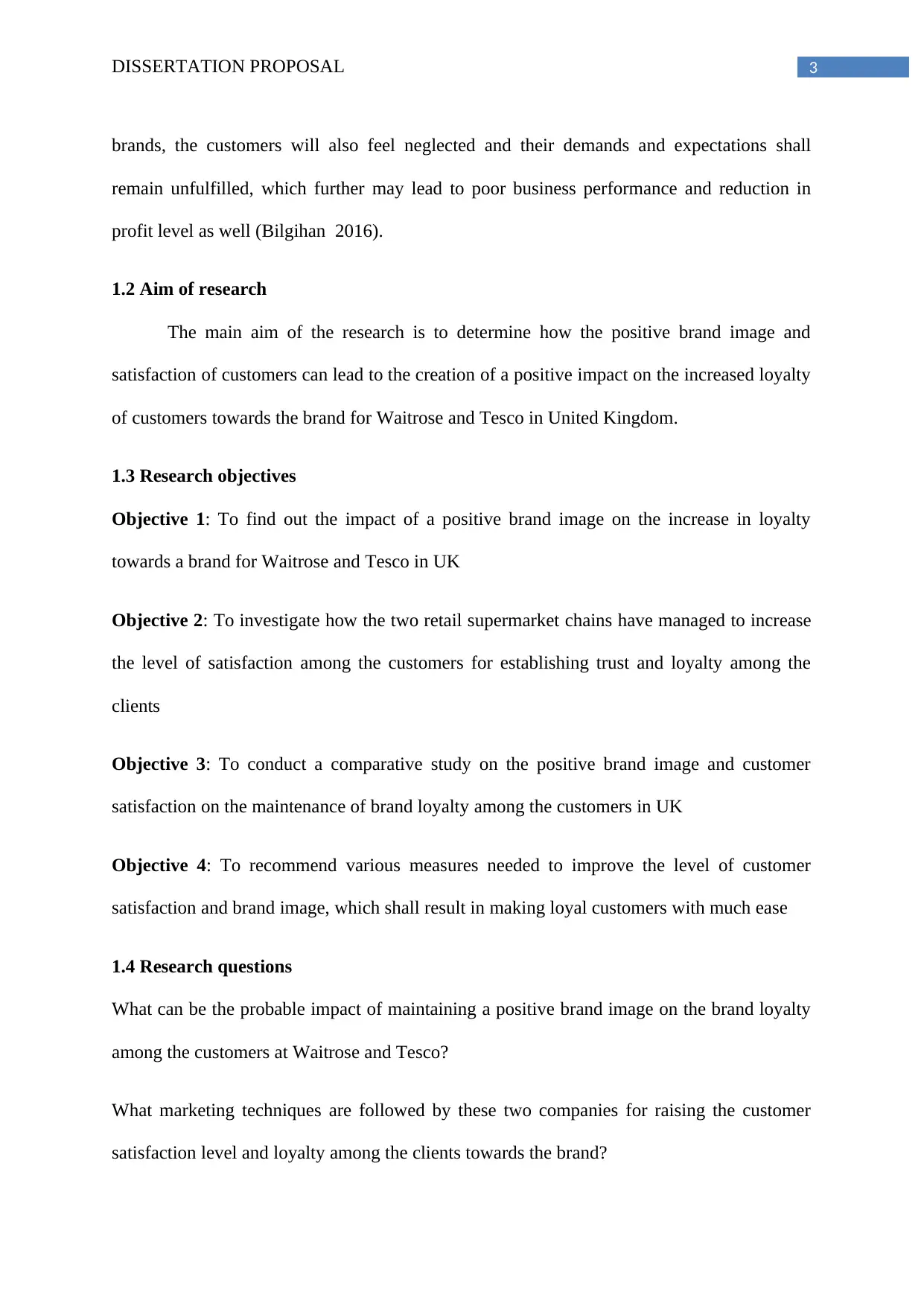
3DISSERTATION PROPOSAL
brands, the customers will also feel neglected and their demands and expectations shall
remain unfulfilled, which further may lead to poor business performance and reduction in
profit level as well (Bilgihan 2016).
1.2 Aim of research
The main aim of the research is to determine how the positive brand image and
satisfaction of customers can lead to the creation of a positive impact on the increased loyalty
of customers towards the brand for Waitrose and Tesco in United Kingdom.
1.3 Research objectives
Objective 1: To find out the impact of a positive brand image on the increase in loyalty
towards a brand for Waitrose and Tesco in UK
Objective 2: To investigate how the two retail supermarket chains have managed to increase
the level of satisfaction among the customers for establishing trust and loyalty among the
clients
Objective 3: To conduct a comparative study on the positive brand image and customer
satisfaction on the maintenance of brand loyalty among the customers in UK
Objective 4: To recommend various measures needed to improve the level of customer
satisfaction and brand image, which shall result in making loyal customers with much ease
1.4 Research questions
What can be the probable impact of maintaining a positive brand image on the brand loyalty
among the customers at Waitrose and Tesco?
What marketing techniques are followed by these two companies for raising the customer
satisfaction level and loyalty among the clients towards the brand?
brands, the customers will also feel neglected and their demands and expectations shall
remain unfulfilled, which further may lead to poor business performance and reduction in
profit level as well (Bilgihan 2016).
1.2 Aim of research
The main aim of the research is to determine how the positive brand image and
satisfaction of customers can lead to the creation of a positive impact on the increased loyalty
of customers towards the brand for Waitrose and Tesco in United Kingdom.
1.3 Research objectives
Objective 1: To find out the impact of a positive brand image on the increase in loyalty
towards a brand for Waitrose and Tesco in UK
Objective 2: To investigate how the two retail supermarket chains have managed to increase
the level of satisfaction among the customers for establishing trust and loyalty among the
clients
Objective 3: To conduct a comparative study on the positive brand image and customer
satisfaction on the maintenance of brand loyalty among the customers in UK
Objective 4: To recommend various measures needed to improve the level of customer
satisfaction and brand image, which shall result in making loyal customers with much ease
1.4 Research questions
What can be the probable impact of maintaining a positive brand image on the brand loyalty
among the customers at Waitrose and Tesco?
What marketing techniques are followed by these two companies for raising the customer
satisfaction level and loyalty among the clients towards the brand?
Paraphrase This Document
Need a fresh take? Get an instant paraphrase of this document with our AI Paraphraser
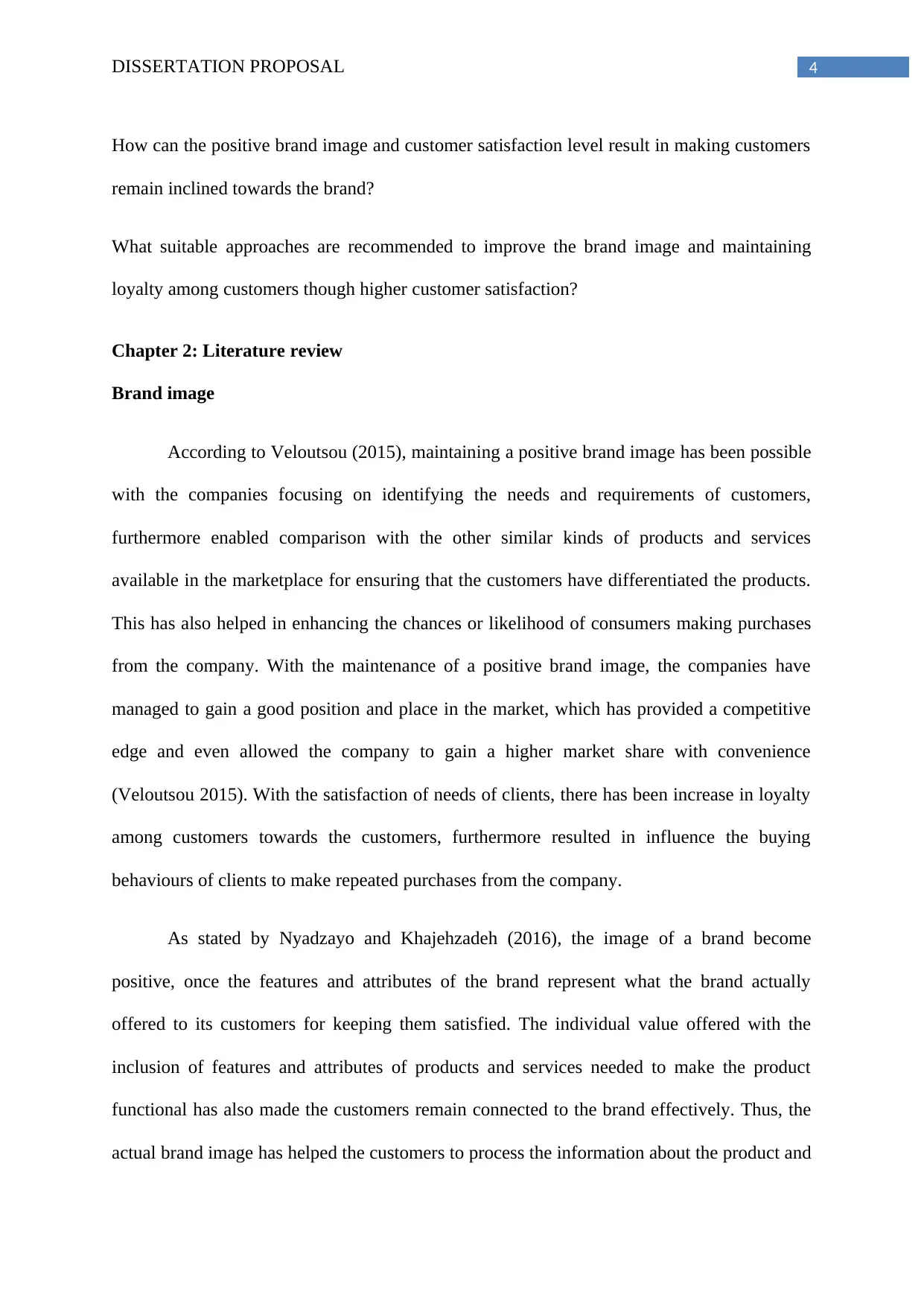
4DISSERTATION PROPOSAL
How can the positive brand image and customer satisfaction level result in making customers
remain inclined towards the brand?
What suitable approaches are recommended to improve the brand image and maintaining
loyalty among customers though higher customer satisfaction?
Chapter 2: Literature review
Brand image
According to Veloutsou (2015), maintaining a positive brand image has been possible
with the companies focusing on identifying the needs and requirements of customers,
furthermore enabled comparison with the other similar kinds of products and services
available in the marketplace for ensuring that the customers have differentiated the products.
This has also helped in enhancing the chances or likelihood of consumers making purchases
from the company. With the maintenance of a positive brand image, the companies have
managed to gain a good position and place in the market, which has provided a competitive
edge and even allowed the company to gain a higher market share with convenience
(Veloutsou 2015). With the satisfaction of needs of clients, there has been increase in loyalty
among customers towards the customers, furthermore resulted in influence the buying
behaviours of clients to make repeated purchases from the company.
As stated by Nyadzayo and Khajehzadeh (2016), the image of a brand become
positive, once the features and attributes of the brand represent what the brand actually
offered to its customers for keeping them satisfied. The individual value offered with the
inclusion of features and attributes of products and services needed to make the product
functional has also made the customers remain connected to the brand effectively. Thus, the
actual brand image has helped the customers to process the information about the product and
How can the positive brand image and customer satisfaction level result in making customers
remain inclined towards the brand?
What suitable approaches are recommended to improve the brand image and maintaining
loyalty among customers though higher customer satisfaction?
Chapter 2: Literature review
Brand image
According to Veloutsou (2015), maintaining a positive brand image has been possible
with the companies focusing on identifying the needs and requirements of customers,
furthermore enabled comparison with the other similar kinds of products and services
available in the marketplace for ensuring that the customers have differentiated the products.
This has also helped in enhancing the chances or likelihood of consumers making purchases
from the company. With the maintenance of a positive brand image, the companies have
managed to gain a good position and place in the market, which has provided a competitive
edge and even allowed the company to gain a higher market share with convenience
(Veloutsou 2015). With the satisfaction of needs of clients, there has been increase in loyalty
among customers towards the customers, furthermore resulted in influence the buying
behaviours of clients to make repeated purchases from the company.
As stated by Nyadzayo and Khajehzadeh (2016), the image of a brand become
positive, once the features and attributes of the brand represent what the brand actually
offered to its customers for keeping them satisfied. The individual value offered with the
inclusion of features and attributes of products and services needed to make the product
functional has also made the customers remain connected to the brand effectively. Thus, the
actual brand image has helped the customers to process the information about the product and
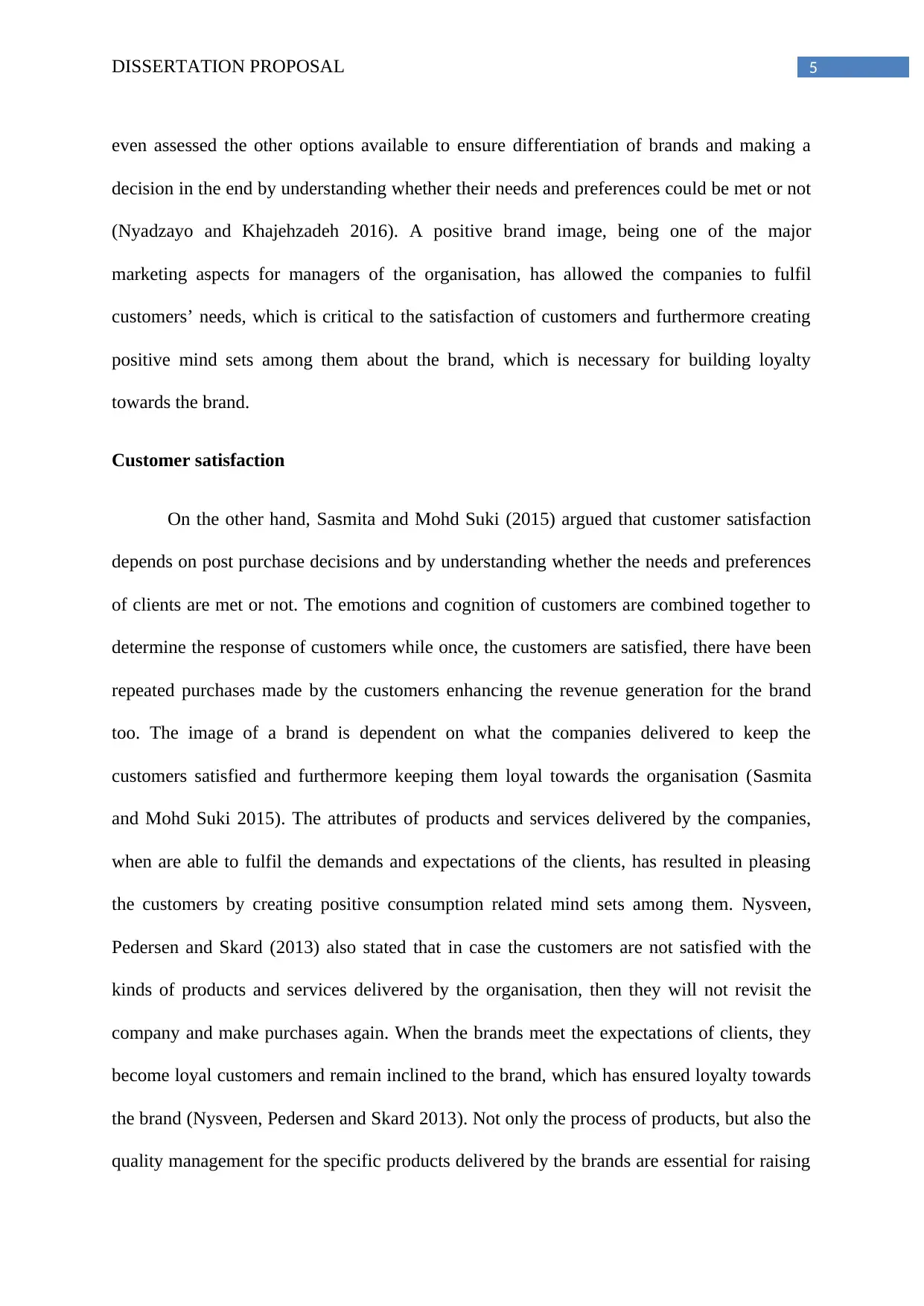
5DISSERTATION PROPOSAL
even assessed the other options available to ensure differentiation of brands and making a
decision in the end by understanding whether their needs and preferences could be met or not
(Nyadzayo and Khajehzadeh 2016). A positive brand image, being one of the major
marketing aspects for managers of the organisation, has allowed the companies to fulfil
customers’ needs, which is critical to the satisfaction of customers and furthermore creating
positive mind sets among them about the brand, which is necessary for building loyalty
towards the brand.
Customer satisfaction
On the other hand, Sasmita and Mohd Suki (2015) argued that customer satisfaction
depends on post purchase decisions and by understanding whether the needs and preferences
of clients are met or not. The emotions and cognition of customers are combined together to
determine the response of customers while once, the customers are satisfied, there have been
repeated purchases made by the customers enhancing the revenue generation for the brand
too. The image of a brand is dependent on what the companies delivered to keep the
customers satisfied and furthermore keeping them loyal towards the organisation (Sasmita
and Mohd Suki 2015). The attributes of products and services delivered by the companies,
when are able to fulfil the demands and expectations of the clients, has resulted in pleasing
the customers by creating positive consumption related mind sets among them. Nysveen,
Pedersen and Skard (2013) also stated that in case the customers are not satisfied with the
kinds of products and services delivered by the organisation, then they will not revisit the
company and make purchases again. When the brands meet the expectations of clients, they
become loyal customers and remain inclined to the brand, which has ensured loyalty towards
the brand (Nysveen, Pedersen and Skard 2013). Not only the process of products, but also the
quality management for the specific products delivered by the brands are essential for raising
even assessed the other options available to ensure differentiation of brands and making a
decision in the end by understanding whether their needs and preferences could be met or not
(Nyadzayo and Khajehzadeh 2016). A positive brand image, being one of the major
marketing aspects for managers of the organisation, has allowed the companies to fulfil
customers’ needs, which is critical to the satisfaction of customers and furthermore creating
positive mind sets among them about the brand, which is necessary for building loyalty
towards the brand.
Customer satisfaction
On the other hand, Sasmita and Mohd Suki (2015) argued that customer satisfaction
depends on post purchase decisions and by understanding whether the needs and preferences
of clients are met or not. The emotions and cognition of customers are combined together to
determine the response of customers while once, the customers are satisfied, there have been
repeated purchases made by the customers enhancing the revenue generation for the brand
too. The image of a brand is dependent on what the companies delivered to keep the
customers satisfied and furthermore keeping them loyal towards the organisation (Sasmita
and Mohd Suki 2015). The attributes of products and services delivered by the companies,
when are able to fulfil the demands and expectations of the clients, has resulted in pleasing
the customers by creating positive consumption related mind sets among them. Nysveen,
Pedersen and Skard (2013) also stated that in case the customers are not satisfied with the
kinds of products and services delivered by the organisation, then they will not revisit the
company and make purchases again. When the brands meet the expectations of clients, they
become loyal customers and remain inclined to the brand, which has ensured loyalty towards
the brand (Nysveen, Pedersen and Skard 2013). Not only the process of products, but also the
quality management for the specific products delivered by the brands are essential for raising
⊘ This is a preview!⊘
Do you want full access?
Subscribe today to unlock all pages.

Trusted by 1+ million students worldwide
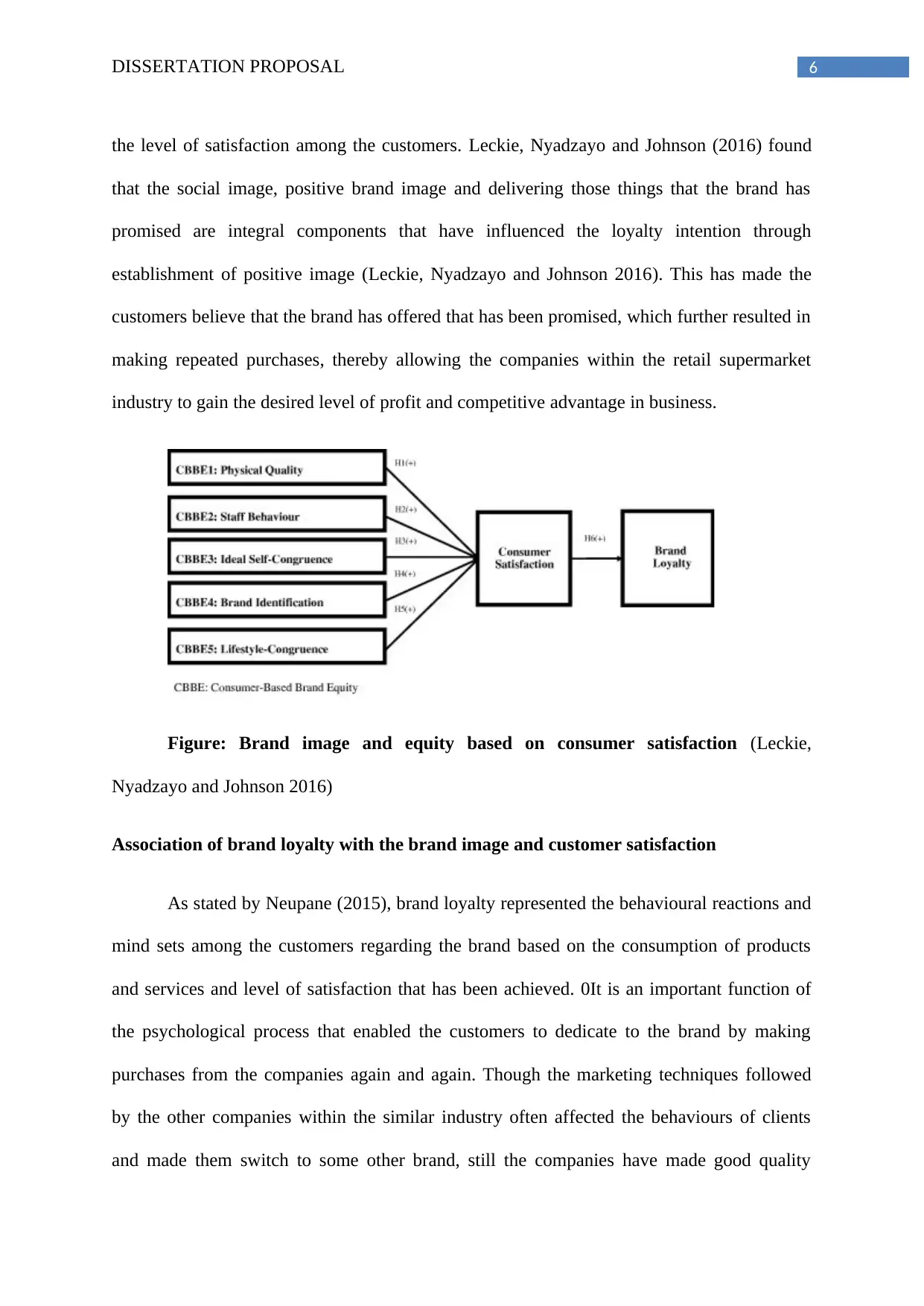
6DISSERTATION PROPOSAL
the level of satisfaction among the customers. Leckie, Nyadzayo and Johnson (2016) found
that the social image, positive brand image and delivering those things that the brand has
promised are integral components that have influenced the loyalty intention through
establishment of positive image (Leckie, Nyadzayo and Johnson 2016). This has made the
customers believe that the brand has offered that has been promised, which further resulted in
making repeated purchases, thereby allowing the companies within the retail supermarket
industry to gain the desired level of profit and competitive advantage in business.
Figure: Brand image and equity based on consumer satisfaction (Leckie,
Nyadzayo and Johnson 2016)
Association of brand loyalty with the brand image and customer satisfaction
As stated by Neupane (2015), brand loyalty represented the behavioural reactions and
mind sets among the customers regarding the brand based on the consumption of products
and services and level of satisfaction that has been achieved. 0It is an important function of
the psychological process that enabled the customers to dedicate to the brand by making
purchases from the companies again and again. Though the marketing techniques followed
by the other companies within the similar industry often affected the behaviours of clients
and made them switch to some other brand, still the companies have made good quality
the level of satisfaction among the customers. Leckie, Nyadzayo and Johnson (2016) found
that the social image, positive brand image and delivering those things that the brand has
promised are integral components that have influenced the loyalty intention through
establishment of positive image (Leckie, Nyadzayo and Johnson 2016). This has made the
customers believe that the brand has offered that has been promised, which further resulted in
making repeated purchases, thereby allowing the companies within the retail supermarket
industry to gain the desired level of profit and competitive advantage in business.
Figure: Brand image and equity based on consumer satisfaction (Leckie,
Nyadzayo and Johnson 2016)
Association of brand loyalty with the brand image and customer satisfaction
As stated by Neupane (2015), brand loyalty represented the behavioural reactions and
mind sets among the customers regarding the brand based on the consumption of products
and services and level of satisfaction that has been achieved. 0It is an important function of
the psychological process that enabled the customers to dedicate to the brand by making
purchases from the companies again and again. Though the marketing techniques followed
by the other companies within the similar industry often affected the behaviours of clients
and made them switch to some other brand, still the companies have made good quality
Paraphrase This Document
Need a fresh take? Get an instant paraphrase of this document with our AI Paraphraser
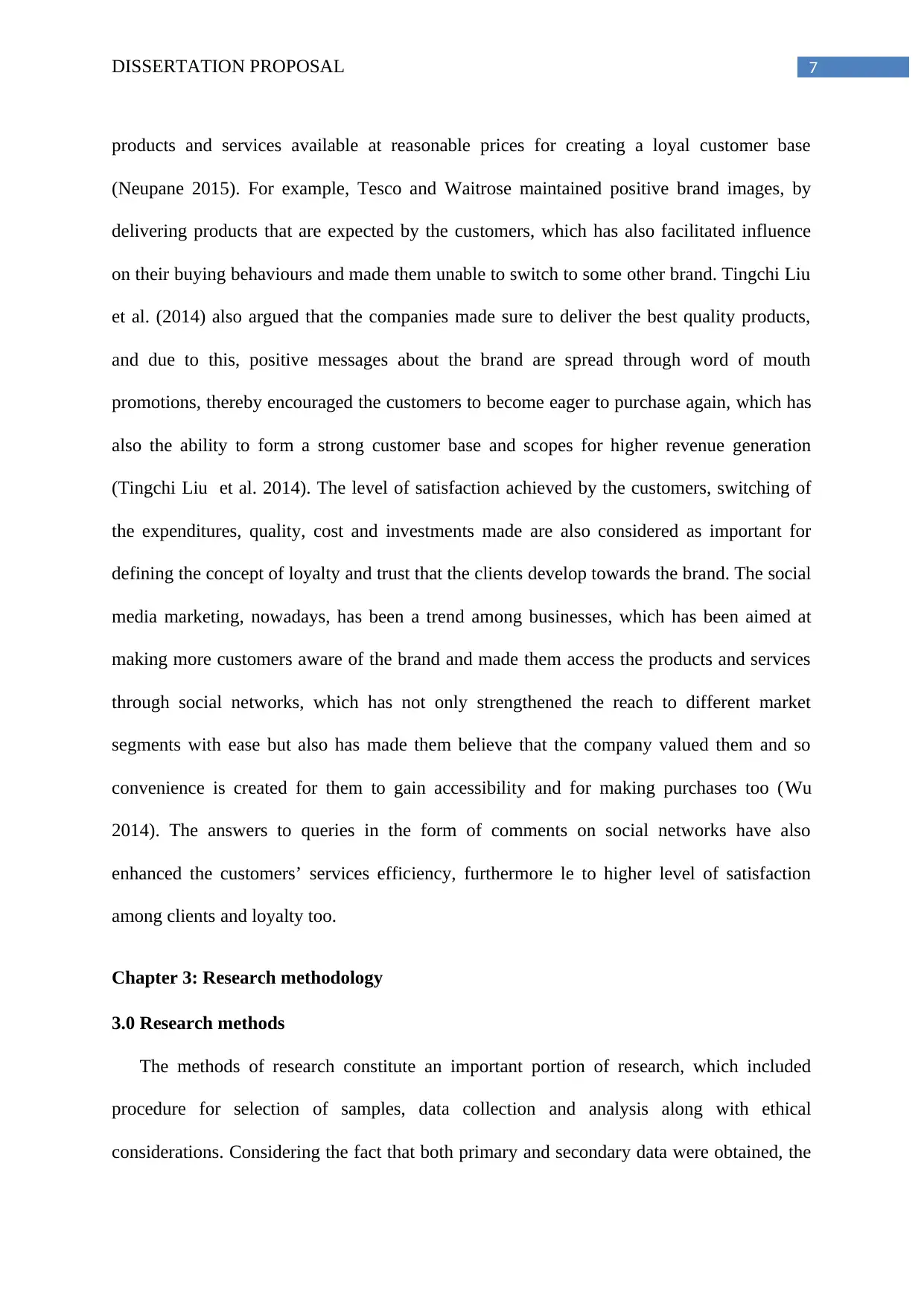
7DISSERTATION PROPOSAL
products and services available at reasonable prices for creating a loyal customer base
(Neupane 2015). For example, Tesco and Waitrose maintained positive brand images, by
delivering products that are expected by the customers, which has also facilitated influence
on their buying behaviours and made them unable to switch to some other brand. Tingchi Liu
et al. (2014) also argued that the companies made sure to deliver the best quality products,
and due to this, positive messages about the brand are spread through word of mouth
promotions, thereby encouraged the customers to become eager to purchase again, which has
also the ability to form a strong customer base and scopes for higher revenue generation
(Tingchi Liu et al. 2014). The level of satisfaction achieved by the customers, switching of
the expenditures, quality, cost and investments made are also considered as important for
defining the concept of loyalty and trust that the clients develop towards the brand. The social
media marketing, nowadays, has been a trend among businesses, which has been aimed at
making more customers aware of the brand and made them access the products and services
through social networks, which has not only strengthened the reach to different market
segments with ease but also has made them believe that the company valued them and so
convenience is created for them to gain accessibility and for making purchases too (Wu
2014). The answers to queries in the form of comments on social networks have also
enhanced the customers’ services efficiency, furthermore le to higher level of satisfaction
among clients and loyalty too.
Chapter 3: Research methodology
3.0 Research methods
The methods of research constitute an important portion of research, which included
procedure for selection of samples, data collection and analysis along with ethical
considerations. Considering the fact that both primary and secondary data were obtained, the
products and services available at reasonable prices for creating a loyal customer base
(Neupane 2015). For example, Tesco and Waitrose maintained positive brand images, by
delivering products that are expected by the customers, which has also facilitated influence
on their buying behaviours and made them unable to switch to some other brand. Tingchi Liu
et al. (2014) also argued that the companies made sure to deliver the best quality products,
and due to this, positive messages about the brand are spread through word of mouth
promotions, thereby encouraged the customers to become eager to purchase again, which has
also the ability to form a strong customer base and scopes for higher revenue generation
(Tingchi Liu et al. 2014). The level of satisfaction achieved by the customers, switching of
the expenditures, quality, cost and investments made are also considered as important for
defining the concept of loyalty and trust that the clients develop towards the brand. The social
media marketing, nowadays, has been a trend among businesses, which has been aimed at
making more customers aware of the brand and made them access the products and services
through social networks, which has not only strengthened the reach to different market
segments with ease but also has made them believe that the company valued them and so
convenience is created for them to gain accessibility and for making purchases too (Wu
2014). The answers to queries in the form of comments on social networks have also
enhanced the customers’ services efficiency, furthermore le to higher level of satisfaction
among clients and loyalty too.
Chapter 3: Research methodology
3.0 Research methods
The methods of research constitute an important portion of research, which included
procedure for selection of samples, data collection and analysis along with ethical
considerations. Considering the fact that both primary and secondary data were obtained, the
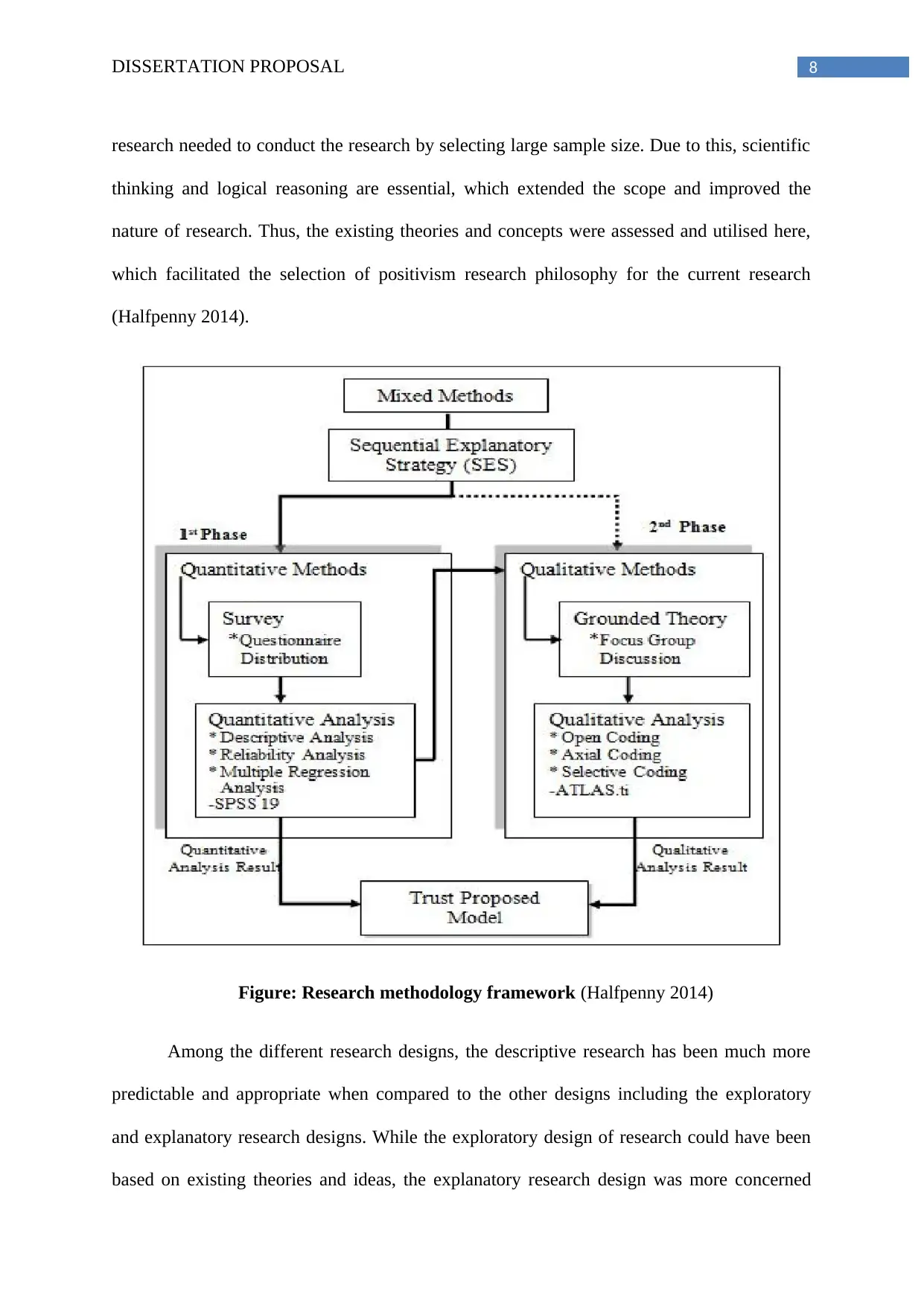
8DISSERTATION PROPOSAL
research needed to conduct the research by selecting large sample size. Due to this, scientific
thinking and logical reasoning are essential, which extended the scope and improved the
nature of research. Thus, the existing theories and concepts were assessed and utilised here,
which facilitated the selection of positivism research philosophy for the current research
(Halfpenny 2014).
Figure: Research methodology framework (Halfpenny 2014)
Among the different research designs, the descriptive research has been much more
predictable and appropriate when compared to the other designs including the exploratory
and explanatory research designs. While the exploratory design of research could have been
based on existing theories and ideas, the explanatory research design was more concerned
research needed to conduct the research by selecting large sample size. Due to this, scientific
thinking and logical reasoning are essential, which extended the scope and improved the
nature of research. Thus, the existing theories and concepts were assessed and utilised here,
which facilitated the selection of positivism research philosophy for the current research
(Halfpenny 2014).
Figure: Research methodology framework (Halfpenny 2014)
Among the different research designs, the descriptive research has been much more
predictable and appropriate when compared to the other designs including the exploratory
and explanatory research designs. While the exploratory design of research could have been
based on existing theories and ideas, the explanatory research design was more concerned
⊘ This is a preview!⊘
Do you want full access?
Subscribe today to unlock all pages.

Trusted by 1+ million students worldwide
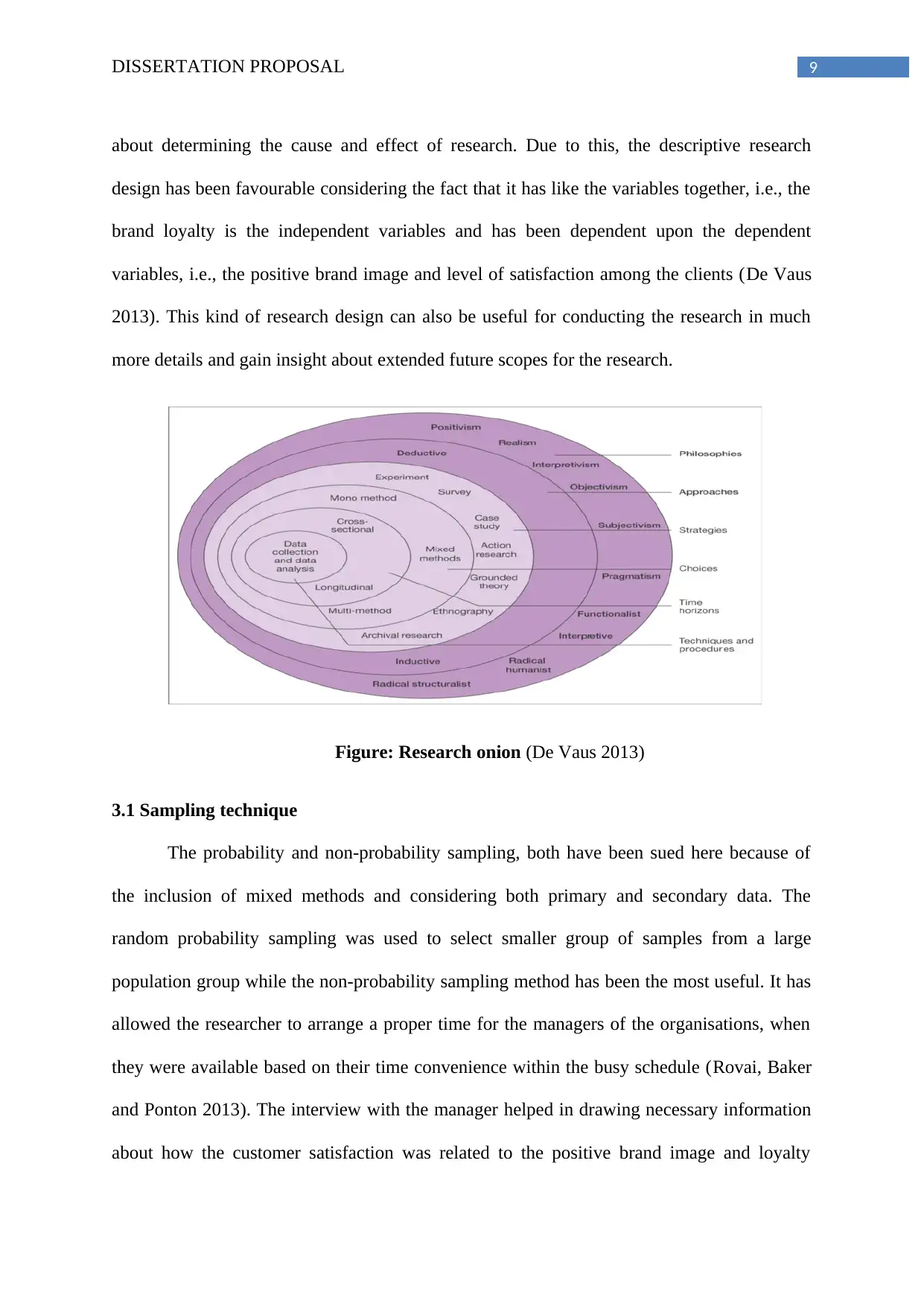
9DISSERTATION PROPOSAL
about determining the cause and effect of research. Due to this, the descriptive research
design has been favourable considering the fact that it has like the variables together, i.e., the
brand loyalty is the independent variables and has been dependent upon the dependent
variables, i.e., the positive brand image and level of satisfaction among the clients (De Vaus
2013). This kind of research design can also be useful for conducting the research in much
more details and gain insight about extended future scopes for the research.
Figure: Research onion (De Vaus 2013)
3.1 Sampling technique
The probability and non-probability sampling, both have been sued here because of
the inclusion of mixed methods and considering both primary and secondary data. The
random probability sampling was used to select smaller group of samples from a large
population group while the non-probability sampling method has been the most useful. It has
allowed the researcher to arrange a proper time for the managers of the organisations, when
they were available based on their time convenience within the busy schedule (Rovai, Baker
and Ponton 2013). The interview with the manager helped in drawing necessary information
about how the customer satisfaction was related to the positive brand image and loyalty
about determining the cause and effect of research. Due to this, the descriptive research
design has been favourable considering the fact that it has like the variables together, i.e., the
brand loyalty is the independent variables and has been dependent upon the dependent
variables, i.e., the positive brand image and level of satisfaction among the clients (De Vaus
2013). This kind of research design can also be useful for conducting the research in much
more details and gain insight about extended future scopes for the research.
Figure: Research onion (De Vaus 2013)
3.1 Sampling technique
The probability and non-probability sampling, both have been sued here because of
the inclusion of mixed methods and considering both primary and secondary data. The
random probability sampling was used to select smaller group of samples from a large
population group while the non-probability sampling method has been the most useful. It has
allowed the researcher to arrange a proper time for the managers of the organisations, when
they were available based on their time convenience within the busy schedule (Rovai, Baker
and Ponton 2013). The interview with the manager helped in drawing necessary information
about how the customer satisfaction was related to the positive brand image and loyalty
Paraphrase This Document
Need a fresh take? Get an instant paraphrase of this document with our AI Paraphraser
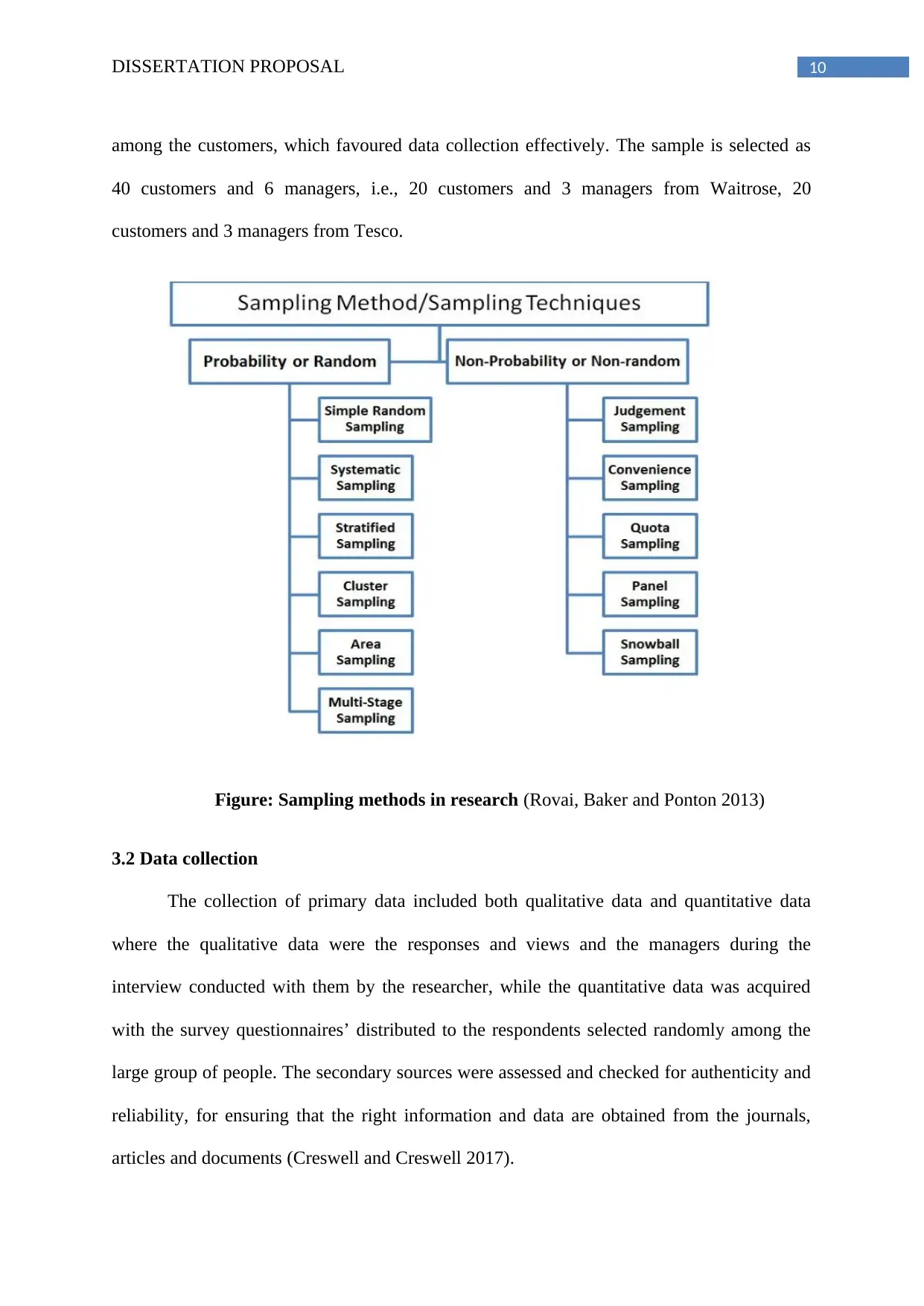
10DISSERTATION PROPOSAL
among the customers, which favoured data collection effectively. The sample is selected as
40 customers and 6 managers, i.e., 20 customers and 3 managers from Waitrose, 20
customers and 3 managers from Tesco.
Figure: Sampling methods in research (Rovai, Baker and Ponton 2013)
3.2 Data collection
The collection of primary data included both qualitative data and quantitative data
where the qualitative data were the responses and views and the managers during the
interview conducted with them by the researcher, while the quantitative data was acquired
with the survey questionnaires’ distributed to the respondents selected randomly among the
large group of people. The secondary sources were assessed and checked for authenticity and
reliability, for ensuring that the right information and data are obtained from the journals,
articles and documents (Creswell and Creswell 2017).
among the customers, which favoured data collection effectively. The sample is selected as
40 customers and 6 managers, i.e., 20 customers and 3 managers from Waitrose, 20
customers and 3 managers from Tesco.
Figure: Sampling methods in research (Rovai, Baker and Ponton 2013)
3.2 Data collection
The collection of primary data included both qualitative data and quantitative data
where the qualitative data were the responses and views and the managers during the
interview conducted with them by the researcher, while the quantitative data was acquired
with the survey questionnaires’ distributed to the respondents selected randomly among the
large group of people. The secondary sources were assessed and checked for authenticity and
reliability, for ensuring that the right information and data are obtained from the journals,
articles and documents (Creswell and Creswell 2017).
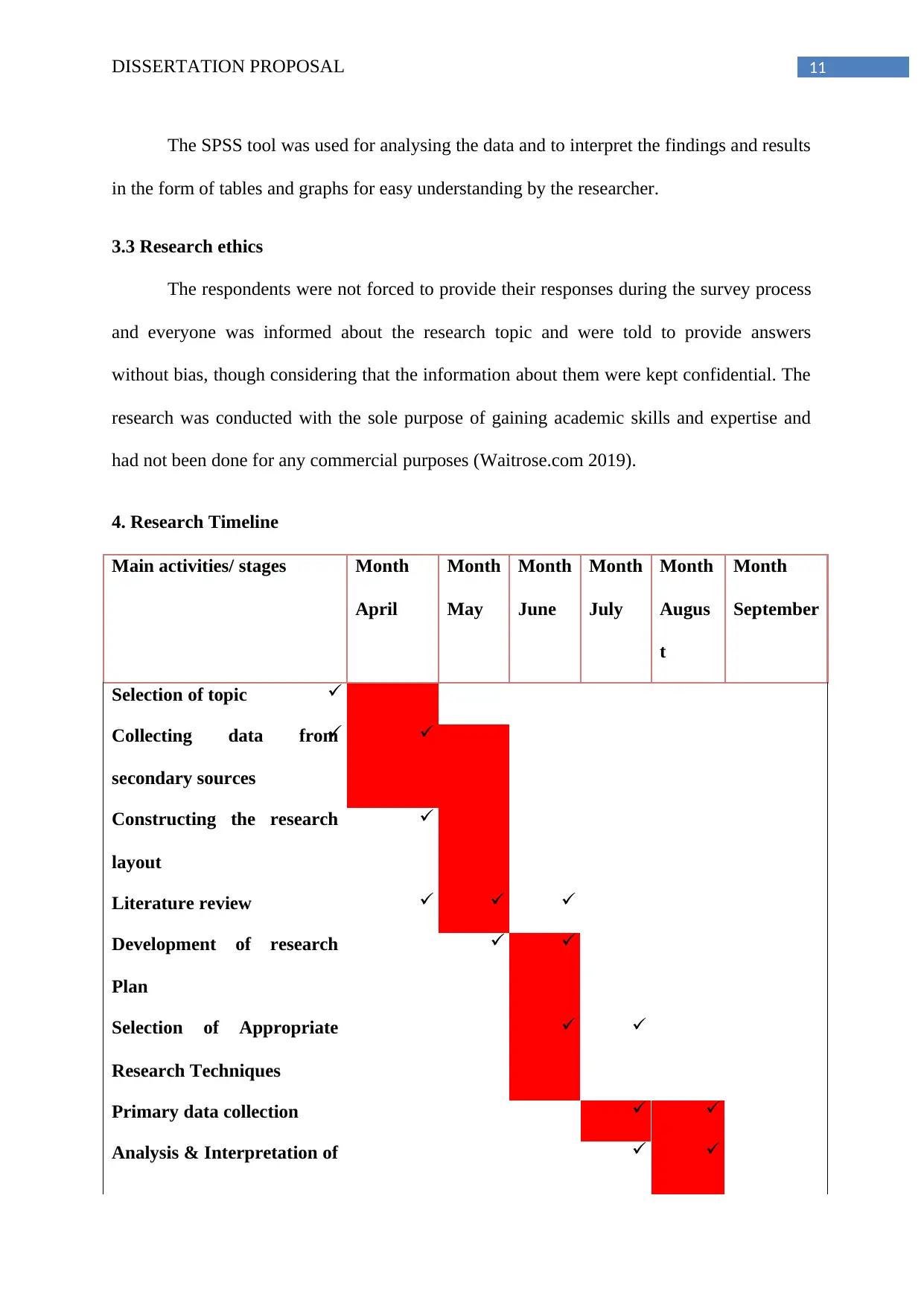
11DISSERTATION PROPOSAL
The SPSS tool was used for analysing the data and to interpret the findings and results
in the form of tables and graphs for easy understanding by the researcher.
3.3 Research ethics
The respondents were not forced to provide their responses during the survey process
and everyone was informed about the research topic and were told to provide answers
without bias, though considering that the information about them were kept confidential. The
research was conducted with the sole purpose of gaining academic skills and expertise and
had not been done for any commercial purposes (Waitrose.com 2019).
4. Research Timeline
Main activities/ stages Month
April
Month
May
Month
June
Month
July
Month
Augus
t
Month
September
Selection of topic
Collecting data from
secondary sources
Constructing the research
layout
Literature review
Development of research
Plan
Selection of Appropriate
Research Techniques
Primary data collection
Analysis & Interpretation of
The SPSS tool was used for analysing the data and to interpret the findings and results
in the form of tables and graphs for easy understanding by the researcher.
3.3 Research ethics
The respondents were not forced to provide their responses during the survey process
and everyone was informed about the research topic and were told to provide answers
without bias, though considering that the information about them were kept confidential. The
research was conducted with the sole purpose of gaining academic skills and expertise and
had not been done for any commercial purposes (Waitrose.com 2019).
4. Research Timeline
Main activities/ stages Month
April
Month
May
Month
June
Month
July
Month
Augus
t
Month
September
Selection of topic
Collecting data from
secondary sources
Constructing the research
layout
Literature review
Development of research
Plan
Selection of Appropriate
Research Techniques
Primary data collection
Analysis & Interpretation of
⊘ This is a preview!⊘
Do you want full access?
Subscribe today to unlock all pages.

Trusted by 1+ million students worldwide
1 out of 15
Related Documents
Your All-in-One AI-Powered Toolkit for Academic Success.
+13062052269
info@desklib.com
Available 24*7 on WhatsApp / Email
![[object Object]](/_next/static/media/star-bottom.7253800d.svg)
Unlock your academic potential
Copyright © 2020–2025 A2Z Services. All Rights Reserved. Developed and managed by ZUCOL.





